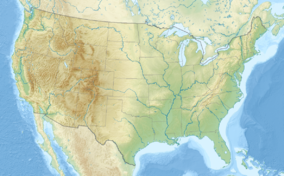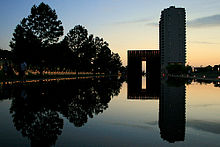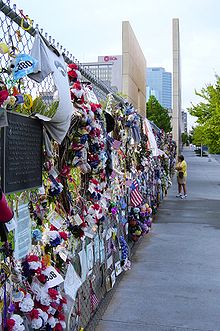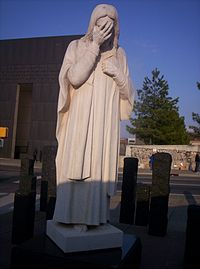- Oklahoma City National Memorial
-
Oklahoma City National Memorial & Museum Location Oklahoma City, Oklahoma, USA Coordinates 35°28′22″N 97°31′2″W / 35.47278°N 97.51722°WCoordinates: 35°28′22″N 97°31′2″W / 35.47278°N 97.51722°W Area 3.3 acres (1.3 ha)
3.12 acres (1.26 ha) federalEstablished October 9, 1997 Visitors 350,000 per year Governing body Oklahoma City Nat'l Memorial Foundation & National Park Service The Oklahoma City National Memorial is a memorial in the United States that honors the victims, survivors, rescuers, and all who were affected by the Oklahoma City bombing on April 19, 1995. The memorial is located in downtown Oklahoma City on the former site of the Alfred P. Murrah Federal Building, which was destroyed in the 1995 bombing. This building was located on NW 5th Street between N. Robinson Avenue and N. Harvey Avenue.
The National Memorial was authorized on October 9, 1997, by President Bill Clinton's signing of the Oklahoma City National Memorial Act of 1997. It was administratively listed on the National Register of Historic Places the same day. The memorial is administered by Oklahoma City National Memorial Foundation, with National Park Service staff to help interpret the memorial for visitors. The National Memorial Museum and the Institute for the Prevention of Terrorism are components housed in the former Journal Record Building on the north side of the memorial grounds.
The memorial was formally dedicated on April 19, 2000: the fifth anniversary of the bombing. The museum was dedicated and opened the following year on February 19.
Contents
History
On April 19, 1995, Timothy McVeigh parked a Ryder rental truck filled with explosives in front of the Alfred P. Murrah Federal Building. The resulting explosion killed 168 people and destroyed the entire north face of the building.[1]
Months after the attack, Mayor Ron Norick appointed a task force to look into a creation of a permanent memorial where the Murrah building once stood. The Task Force called for 'a symbolic outdoor memorial', a Memorial Museum, and for creation of Oklahoma City National Memorial Institute for the Prevention of Terrorism. Six hundred and twenty four designs were submitted for the memorial and on July 1997 a design by Butzer Design Partnership, which consists of the husband and wife, Hans and Torrey Butzer was chosen.[2][3]
On October 1997, President Bill Clinton signed law creating the Oklahoma City National Memorial as a unit of the National Park Service to be operated by the Oklahoma City National Memorial Trust. The total cost of the memorial was $29.1 Million; $10 Million for the Outdoor Symbolic Memorial, $7 Million for the Memorial Museum, $5 Million for the Memorial Institute for the Prevention of Terrorism and the rest for other costs.[3] The Federal Government appropriated $5 Million for construction with the State of Oklahoma matching that amount. More than $17 Million of private donations were raised.[2]
On April 19, 2000 the fifth anniversary of the attack, the Outdoor Symbolic Memorial was dedicated. On February 19, 2001 the Memorial Museum was dedicated.[2] The Oklahoma City National Memorial since its opening has seen over 4.4 million visitors to the Outdoor Symbolic Memorial and 1.6 million visitors to the Memorial Museum.[2] The Memorial has an average of 350,000 visitors per year.[3]
Memorial features
The Outdoor Symbolic Memorial consists of the following segments on 3.3 acres (13,000 m2); it can be visited 24 hours a day, 365 days a year.
- The Gates of Time: Monumental twin bronze gates frame the moment of destruction - 9:02 - and mark the formal entrances to the Outdoor Memorial. 9:01, found on the eastern gate, represents the last moments of peace, while its opposite on the western gate, 9:03, represents the first moments of recovery. Both time stamps are inscribed on the interior of the monument, facing each other and the Reflecting Pool.[3][4]
- The outside of each gate bears this inscription:
We come here to remember Those who were killed, those who survived and those changed forever. May all who leave here know the impact of violence. May this memorial offer comfort, strength, peace, hope and serenity.
- Reflecting Pool: A thin layer of water flows over polished black granite to form the pool, which runs east to west down the center of the Memorial (also see reflecting pool) on what was once Fifth Street. Visitors' seeing their reflections are seeing "someone changed forever by what happened here."[3][4]
- Field of Empty Chairs: 168 empty chairs hand-crafted from glass, bronze, and stone represent those who lost their lives, with a name etched in the glass base of each. They sit on the site where the Murrah Building once stood. The chairs represent the empty chairs at the dinner tables of the victims' families. The chairs are arranged in nine rows to symbolize the nine floors of the building; each person's chair is on the row (or the floor) on which the person worked or was located when the bomb went off. The chairs are also grouped according to the blast pattern, with the most chairs nearest the most heavily damaged portion of the building. The westernmost column of five chairs represents the five people who died but were not in the Murrah Building (two in the Water Resources Board building, one in the Athenian Building, one outside near the building, and one rescuer). The 19 smaller chairs represent the children killed in the bombing. Three unborn children died along with their mothers, and they are listed on their mothers' chairs beneath their mothers' names.[3][4]
- Survivors' Wall: The only remaining original portions of the Murrah Building are the southeast corner, known as the Survivors' Wall, and a portion of the south wall. The Survivors' Wall includes several panels of granite salvaged from the Murrah Building itself, inscribed with the names of more than 600 survivors from the building and the surrounding area, many of whom were injured in the blast.[4]
- The Survivor Tree: An American elm on the north side of the Memorial, this was the only shade tree in the parking lot across the street from the Murrah Building. Commuters arrived early to get one of the shady parking spots provided by its branches. Photos of Oklahoma City taken in the 1920s show the tree to be about 100 years old.[5] The tree was taken for granted prior to the blast. Heavily damaged by the bomb, the tree survived after nearly being chopped down during the initial investigation, when workers wanted to recover evidence hanging in its branches and embedded in its bark.[6]
The force of the blast ripped most of the branches from the Survivor Tree, glass and debris were embedded in its trunk and fire from the cars parked beneath it blackened what was left. Most thought the tree could not survive. Almost a year after the bombing, family members, survivors and rescue workers gathered for a memorial ceremony by the tree noticed it was beginning to bloom again. The Survivor Tree now thrives, as the Outdoor Memorial design included a mandate to feature and protect the tree. For example, one of the roots that would have been cut by the wall surrounding the tree was placed inside a large pipe, so it could reach the soil beyond the wall without being damaged. The decking around the tree was raised several feet to make an underground crawlspace; workers enter through a secure hatchway and monitor the health of the tree and maintain its very deep roots.[3][6]
- The inscription around the inside of the deck wall around the Survivor Tree reads:
The spirit of this city and this nation will not be defeated; our deeply rooted faith sustains us.Hundreds of seeds from the Survivor Tree are planted annually and the resulting saplings are distributed each year on the anniversary of the bombing. Thousands of Survivor Trees are growing in public and private places all over the United States.[6]
- The Memorial Fence: A 10-foot-tall (3.0 m) chain link fence was installed around the area that is now the Reflecting Pool and the Field of Empty Chairs to protect the site from damage and visitors from injury. The Fence stood for more than four years, becoming notable as the place where visitors left stuffed animals, poems, keychains, and other items as tributes. During the construction of the Outdoor Memorial, 210 feet (64 m) of the Fence was moved to the west side of the Memorial, along the 9:03 side or the 'healing' side. The remainder of the Fence is in storage. Visitors may still leave small items along and in the Fence; the mementos are periodically collected, cataloged, and stored.[3][4]
- Rescuers' Orchard: A grove of Oklahoma redbuds (Oklahoma's state tree), Amur Maple, Chinese Pistache, and Bosque Elm trees are planted on the lawn around the Survivor Tree.[3]
- Children's Area: More than 5,000 hand-painted tiles, from all over the United States and Canada, were made by children and sent to Oklahoma City after the bombing in 1995. Most are stored in the Memorial's Archives, and a sampling of tiles is on the wall in the Children's Area. Chalkboards provide a place where children can draw and share their feelings. The Children's Area is north of the 9:03 gate, on the west side of the Museum.[3]
- And Jesus Wept: On a corner adjacent to the memorial is a sculpture of Jesus weeping, erected by St. Joseph's Catholic Church. St. Joseph's, one of the first brick-and-mortar churches built in the city, was almost destroyed by the blast. Not officially part of the memorial, the statue is regularly visited.[7]
- Journal Record Building: North of the memorial is the Journal Record Building, which formerly housed the offices of the The Journal Record. It now houses the Oklahoma City National Memorial Museum, which features numerous exhibits and artifacts related to the Oklahoma City bombing.[2] Staff of the National Memorial Institute for the Prevention of Terrorism, a non-partisan think tank created shortly after the bombing by family members and survivors, also work here to spread knowledge of terrorism and its prevention.[8]
- Alfred P. Murrah Federal Building Plaza: Located just south of the Field of Empty Chairs, above the underground parking garage, is the raised Alfred P. Murrah Federal Building Plaza. An original part of the federal building, the plaza had a garden and seating areas, as well as a playground for the daycare center. Visitors to the Memorial can walk across the plaza, where the original flagpole is used for the American flag.[3]
References
- ^ Oklahoma City National Memorial & Museum. "Building and Memorial Site". http://www.oklahomacitynationalmemorial.org/secondary.php?section=1&catid=49. Retrieved 2011-04-10.
- ^ a b c d e Oklahoma City National Memorial & Museum. "History and Mission". http://www.oklahomacitynationalmemorial.org/secondary.php?section=1&catid=193. Retrieved 2011-04-10.
- ^ a b c d e f g h i j k National Park Service. "Frequently Asked Questions". http://home.nps.gov/okci/faqs.htm. Retrieved 2011-04-10.
- ^ a b c d e Oklahoma City National Memorial & Museum. "Symbolism". http://www.oklahomacitynationalmemorial.org/secondary.php?section=2&catid=30. Retrieved 2010-04-10.
- ^ University of Arkansas Division of Agriculture. "Survivor Tree (American Elm) Plant of the Week". http://www.arhomeandgarden.org/plantoftheweek/articles/Survivor_Tree.htm. Retrieved 2011-04-11.
- ^ a b c Oklahoma City National Memorial & Museum. "Survivor Tree". http://www.oklahomacitynationalmemorial.org/secondary.php?section=5&catid=120. Retrieved 2010-04-10.
- ^ St.Joseph Old Cathedral. "About Us". http://www.stjosepholdcathedral.org/AboutUs.asp. Retrieved 2011-04-12.
- ^ Memorial institute for the Prevention of Terrorism. "About Us". http://www.mipt.org/AboutMIPT/History.aspx. Retrieved 2011-04-10.
- Bibliography
- The National Parks: Index 2001–2003. Washington: U.S. Department of the Interior.
 This article incorporates public domain material from websites or documents of the National Park Service.
This article incorporates public domain material from websites or documents of the National Park Service.External links
- Oklahoma City National Memorial Official website
- NPS website: Oklahoma City National Memorial
- NewsOK.com report and archive on the Oklahoma City Bombing
- Aerial view of the Memorial: Google Maps
City of Oklahoma City Districts Adventure District · Asia District · Capitol Hill · Downtown · Eastside · Midtown · Paseo · 39th Street · Uptown · Western AvenueProfessional sports teams Oklahoma City Thunder · Oklahoma City Barons · Oklahoma City Lightning · Oklahoma City RedHawks · Bricktown BrawlersFederal National Forests:Oklahoma City National MemorialNational Wildlife Refuges:Deep Fork • Little River • Optima • Ozark Plateau • Salt Plains • Sequoyah • Tishomingo • Washita • Wichita MountainsState Adair • Alabaster Caverns • Arrowhead • Beaver Dunes • Beavers Bend Resort Park • Bernice • Black Mesa • Boggy Depot • Boiling Springs • Boswell Lake • Brushy Lake • Cherokee • Cherokee Landing • Clayton Lake • Crowder Lake • Disney/Little Blue • Dripping Springs • Fort Cobb • Foss • Gloss Mountain • Great Plains • Great Salt Plains • Greenleaf • Heavener Runestone • Hochatown • Honey Creek • Hugo Lake • Keystone • Lake Eucha • Lake Eufaula • Lake Murray • Lake Texoma • Lake Wister • Lake Thunderbird • Little Sahara • McGee Creek • Natural Falls • Okmulgee • Osage Hills • Quartz Mountain • Raymond Gary • Red Rock Canyon • Robbers Cave • Roman Nose • Sequoyah Bay • Sequoyah/Western Hills • Snowdale • Spavinaw • Talimena • Tenkiller • Twin Bridges • Wah-Sha-She • Walnut CreekCategories:- 1997 establishments in the United States
- Museums established in 1997
- Museums in Oklahoma City, Oklahoma
- National Memorials of the United States
- Oklahoma City bombing
- National Register of Historic Places in Oklahoma
- History museums in Oklahoma
- Monuments and memorials in Oklahoma
- United States National Park Service areas in Oklahoma
- Labor monuments and memorials
- Protected areas of Oklahoma County, Oklahoma
- Visitor attractions in Oklahoma City, Oklahoma
Wikimedia Foundation. 2010.







